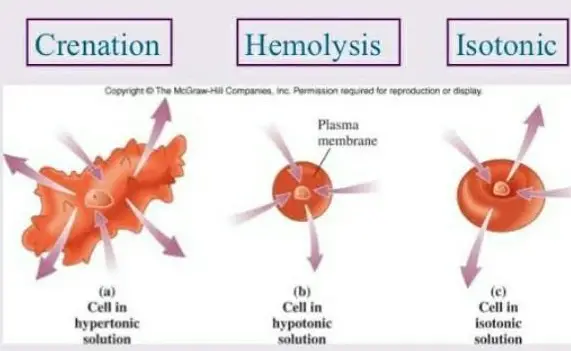Cells are fundamental units of life, and their ability to adapt to various environments is crucial for survival. One such adaptation involves how cells respond to hypertonic solutions, which can have significant effects on their structure and function. When exposed to these environments, cells undergo specific processes, such as crenation in animal cells and plasmolysis in plant cells, which are vital for understanding cellular behavior.
Crenation and plasmolysis are two distinct processes that occur when cells are placed in hypertonic solutions, causing them to lose water. Crenation refers to the shrinking of animal cells, where the cell membrane collapses inward due to water loss. In contrast, plasmolysis happens in plant cells when the cell membrane detaches from the cell wall as it loses water and contracts.
These processes highlight the cell’s dynamic nature and its ability to respond to osmotic stress. While crenation and plasmolysis both result from hypertonic environments, their occurrences in different cell types underpin varied biological implications and structural changes, which are essential in both academic studies and practical applications.

Cell Basics
Definition of a Cell
A cell is the smallest unit of life, fundamental to all living organisms. It is the basic structural, functional, and biological unit that makes up all organisms. Cells can perform all necessary functions of life independently, including metabolism, reproduction, and response to external stimuli.
Role of the Cell Membrane
The cell membrane, also known as the plasma membrane, plays a crucial role in maintaining the integrity and functionality of a cell. It acts as a barrier that separates the interior of the cell from its external environment. Key functions of the cell membrane include:
- Regulating what enters and exits the cell, ensuring that essential nutrients come in and waste products are expelled.
- Protecting the cell from external threats and mechanical stress.
- Communicating with other cells through receptor proteins that can detect environmental changes and signal internal adjustments.
Hypertonic Solutions
Definition and Characteristics
A hypertonic solution refers to a solution that has a higher concentration of solutes outside the cell compared to the inside. When cells are placed in these solutions, they experience osmotic pressure that forces water to move out of the cell, potentially causing cells to shrink.
Effects on Cells
Exposure to hypertonic solutions can have various effects on cells, including:
- Water loss: Cells lose water, leading to dehydration.
- Volume reduction: Cells decrease in size due to water expulsion.
- Concentration of cytoplasm: As water leaves, the cytoplasm becomes more concentrated.
What is Crenation?
Definition of Crenation
Crenation occurs when animal cells, such as red blood cells, are placed in hypertonic solutions causing them to shrink and develop a scalloped surface.
How Crenation Occurs in Cells
Crenation follows these steps:
- Cell in hypertonic solution: The external solution’s solute concentration is higher than that inside the cell.
- Water moves out: Osmosis drives water from inside the cell to the outside.
- Cell shrinks: As water leaves, the cell volume decreases.
- Surface changes: The cell membrane pulls inward at various points, leading to a scalloped appearance.
Visual Characteristics of Crenated Cells
Crenated cells typically exhibit:
- Scalloped, irregular shape: Unlike their normally smooth and uniform shape.
- Smaller size: Significantly reduced compared to normal conditions.
What is Plasmolysis?
Definition of Plasmolysis
Plasmolysis is a phenomenon observed in plant cells when exposed to hypertonic solutions, leading to the detachment of the cell membrane from the cell wall.
Process and Stages of Plasmolysis
Plasmolysis involves the following stages:
- Initial shrinkage: As water leaves, the cell’s volume decreases slightly.
- Membrane detachment: The cell membrane pulls away from the cell wall.
- Space formation: A visible gap appears between the cell wall and the membrane.
Visual Characteristics of Plasmolysed Cells
Plasmolysed cells can be identified by:
- Gap between cell wall and membrane: Clearly visible under a microscope.
- Shrunken cytoplasm: The cytoplasm contracts and becomes dense.
- Maintained cell wall: The rigid cell wall remains intact despite the cell’s internal contraction.
Key Differences
Cellular Contexts of Crenation vs. Plasmolysis
While both crenation and plasmolysis occur in hypertonic environments, the cellular context of each process is markedly different. Crenation typically affects animal cells that lack a rigid cell wall, making them more susceptible to changes in shape and volume when water is lost. In contrast, plasmolysis occurs in plant cells, which are equipped with a cell wall that maintains structural integrity even as the cell membrane detaches and the cell shrinks internally.
Impact on Animal vs. Plant Cells
The impact of hypertonic environments on animal and plant cells can be summarized as follows:
- Animal cells: Experience a loss of shape and volume leading to potential cell dysfunction or death if the hypertonic condition persists.
- Plant cells: Although the cell structure is maintained by the cell wall, the detachment of the cell membrane can disrupt normal cellular functions, potentially leading to reduced photosynthetic activity and growth.
Physical Appearances Compared
Visual comparison of crenated and plasmolysed cells under a microscope reveals significant differences:
- Crenated cells: Appear shriveled with a bumpy, irregular outer membrane.
- Plasmolysed cells: Display a clear gap between the cell wall and the shrunken membrane, maintaining a more defined rectangular or square shape due to the rigidity of the cell wall.
Biological Implications
Consequences of Crenation and Plasmolysis
The biological implications of crenation and plasmolysis are critical in understanding how cells manage osmotic stress:
- Crenation: May lead to impaired cell function or apoptosis in animal cells due to significant morphological changes.
- Plasmolysis: Can result in decreased cell turgidity, affecting plant growth and the ability of plants to stand upright.
Adaptations and Responses of Cells
Cells have evolved various adaptations to cope with hypertonic stress:
- Animal cells: Some cells increase their internal solute concentration to counteract water loss, a process known as osmoregulation.
- Plant cells: Accumulate solutes like proline and sugars to help maintain water within the cell, despite external hypertonic conditions.
Relevance in Real World
Practical Examples in Science and Industry
Crenation and plasmolysis have practical applications in various fields:
- Food preservation: Hypertonic solutions are used to inhibit bacterial growth in food products.
- Biotechnology: Control of environmental conditions to optimize the growth of cultured cells and tissues.
Importance in Medical and Biological Research
Understanding these processes is crucial for:
- Medical treatments: Managing dehydration and fluid imbalances in clinical settings.
- Agricultural science: Developing drought-resistant plant varieties by understanding how plants respond to osmotic stress.
Prevention and Control
How to Prevent Adverse Effects
To mitigate the negative impacts of hypertonic environments, several strategies can be employed:
- Medical interventions: Use of isotonic solutions in intravenous fluids to avoid crenation of blood cells.
- Agricultural practices: Application of appropriate irrigation techniques to prevent soil salinity that can lead to plasmolysis in crops.
Controlling Conditions in Lab Settings
Maintaining optimal conditions in laboratories involves:
- Cell cultures: Regular monitoring of solute concentrations in media to ensure cell health and prevent crenation or plasmolysis.
- Experimental setups: Adjusting the osmolarity of solutions used in experiments to mimic physiological conditions or test cellular responses to stress.
Frequently Asked Questions
What causes crenation in cells?
Crenation in cells occurs when animal cells are exposed to hypertonic solutions, leading to water exiting the cell via osmosis. This results in the cell shrinking and the cell membrane wrinkling or crenating.
How does plasmolysis differ from crenation?
Plasmolysis is specific to plant cells and occurs under similar hypertonic conditions. However, instead of shrinking, the cell membrane of a plant cell detaches from the cell wall as the cell loses water, which does not happen in animal cells during crenation.
Why is understanding these processes important?
Understanding crenation and plasmolysis is crucial for various scientific fields, including botany, biology, and medicine, as it helps predict how cells react under stress, aiding in disease research and the development of treatments.
Can crenation be reversed?
Crenation is typically reversible if the cell’s external environment is promptly restored to isotonic conditions. This allows water to re-enter the cell, returning it to its normal shape.
What practical applications do these processes have?
Both processes have practical applications in medical and biological research, such as studying cell health, developing cryopreservation techniques, and optimizing conditions in tissue culture and laboratory experiments.
Conclusion
The phenomena of crenation and plasmolysis serve as fundamental examples of how cells interact with their environment. These processes are not only pivotal for students and researchers in understanding cellular behavior but also play a crucial role in practical applications across scientific disciplines. By studying these responses, scientists can better understand cellular mechanics and develop strategies to manage cells in various conditions.
Through recognizing the distinctions and similarities between crenation and plasmolysis, researchers continue to uncover new insights into cell physiology, paving the way for innovations in healthcare and plant science. This knowledge remains essential for the advancement of both academic inquiry and practical applications, enhancing our ability to harness cellular responses for beneficial outcomes.

